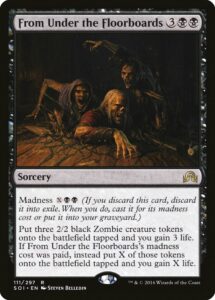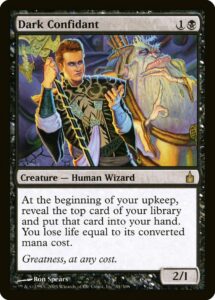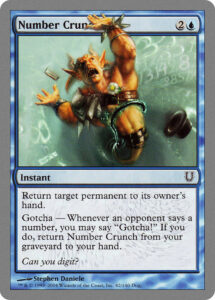Goblin Piker is a quintessentially bad card. Sure, sometimes it’s better than Maritime Guard (which has higher combined stats). And yes, there’s the rare set like the original Zendikar where you’ll play every two drop you can get your hands on. But it probably isn’t controversial to say that Goblin Piker was far below par a decade ago and is even more so today. Nowadays, the only vanilla 2/1s for 2 we see are artifacts like Field Creeper and blue creatures like Curio Vendor—the places we’d expect to see the weakest creatures.
So, what’s the point of talking about discussing a card that wasn’t impressive even in ’98? It’s got a great little humorous story about how dumb goblins can be, but there’s more to it. It defines a power level floor.
Nowhere to Go But Up
Goblin Piker has the worst stats available to a vanilla two-mana creature. The record for utter worst vanilla two drop probably goes to Squire, but both it and our spear-wielding goblin friend have a combined power and toughness of only three. Their stats are so poor that they need buffs just to be printable. And even with buffs, cards like Child of Night, Fissure Wizard, Relic Runner, and Jousting Dummy are more filler than powerhouses.
There’s something really, really nice about having a floor upon which to build. Give a game designer a 2/1 for two and they know it has plenty of wiggle room. You can give it any keyword worth half a mana or less (Vigilance, Prowess, Deathtouch, Reach, Trample) and it probably still isn’t powerful. You can give it trinket text to help communicate about the world (though cards like Audacious Infiltrator and Kor Castigator being only mediocre demonstrates just how much wiggle room there is). And of course, you can buff its stats to fit the needs of the set. But start with a 2/2 for two and you’ve a lot less freedom to buff (though more so now that common creatures are about half a mana stronger than they were five years ago). Start with a 2/3 and you’re heavily restricted (at common, it’ll need a downside or to cost two colored mana).
When designing game components, it’s super helpful to have known frames of reference such as floors you can build upon. Similarly, give a player with just a little experience a 2/1 for two and they’ll either immediately recognize or soon learn that they can do better.
Let’s Do Better
Some of Magic’s best creatures are Goblin Pikers that maxed out on buffs (and put none of those buffs into power and toughness). Young Pyromancer, Snapcaster Mage, and Dark Confidant are arguably their colors’ best two drops (or once unequivocally held that title); and all hearken back to the lowly Skeletal Snake (which predates Goblin Piker by a card). They all do an excellent job of communicating how useful a 2/1 is (once you give it enough power to justify inclusion in a Constructed deck)—two power provides a small, but appreciable burst of damage, while one toughness makes them fragile enough to trade with (essentially) all creatures and removal spells. Their frailty encourages you to attack with them, helping push games to a conclusion (every game benefits from ending before it overstays its welcome).
I think empowered Goblin Pikers accordingly play far better than souped-up Squires. A 1/2 is a far weaker arrangement of power and toughness, meaning they need even more power elsewhere. While Lotus Cobra and Thalia, Guardian of Thraben are relevant threats, Stoneforge Mystic and Priest of the Forgotten Gods function more like enchantments that die to creature removal and make 1/1s sad. Fill a format with playable 2/1s and players can attack (trading one-for-one with their opponents). Fill a format with playable 1/2s and no one can attack (since your creature will get double blocked and die). Now that’s not to say that there’s no place for 1/2s in Magic; but as Magic continues to print new and stronger creatures, it’s probably best if more of them attack better than they block (or if they don’t, they’re cards like Voyaging Satyr whose abilities preclude their use in combat).
Splitting Hairs
All of this math changes once you add or remove a mana. A one mana Goblin Piker or Squire has far less flexibility and requires far more text to be balanced—after all, you’ve cut the cost in half! (Thraben Inspector says hello.) But go up to three mana and you can probably get double your buff—the more expensive you go, the more bang you get for each point of mana, thanks to how the mana system works.
I’d bet good money that there aren’t firm rules within Wizards of the Coast about exactly how the power, toughness, and keyword math works at each converted mana cost. Too many brand new cards come along, and too many things shift over time for there to be such structures. But I’d also wager that Magic employs rules of thumb like Goblin Piker being the floor for two drops, to make every stage of the design process easier. I’m always looking for these baselines when I’m balancing numbers, especially when I’m considering small numbers where the tiniest tweak yields dramatic results (like going for CMC 2 to 1 or increasing power from 2 to 3).
As game designers and Magic card evaluators, we benefit from forming our own heuristics to evaluate and contrast different components. Yes, they can lead us astray, since two things can look similar yet be drastically different (like Dark Confidant and Pain Seer); but rules of thumb are for providing guidance and directions, not explicit roadmaps. Goblin Piker can’t tell you what the most juiced Questing Beast version of itself can exist, but it can tell you how weak is too weak. And that’s a more helpful starting place than many.
Zachary Barash is a New York City-based game designer and the commissioner of Team Draft League. He designs for Kingdom Death: Monster, has a Game Design MFA from the NYU Game Center, and does freelance game design. When the stars align, he streams Magic (but the stars align way less often than he’d like).




